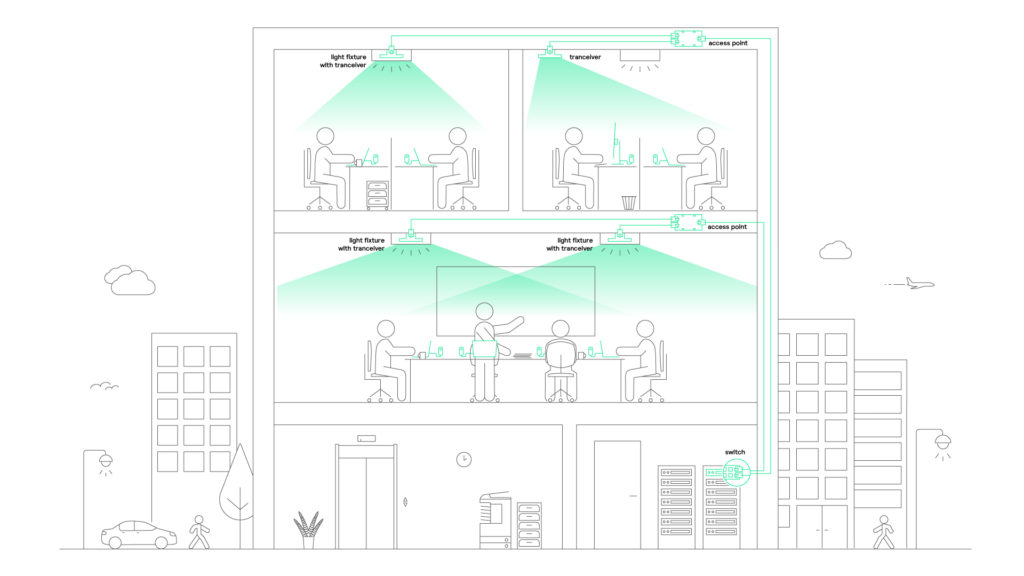What is G.vlc LiFi?
Wireless connectivity is a must-have as more wireless devices than ever go online. Conventional wireless connectivity solutions use the crowded radio spectrum to communicate. What’s more, there are areas where radio-based wireless connectivity is not permitted or the best fit.
This is where LiFi comes in. LiFi can provide two-way wireless communication with high speed, physical layer security and low latency.
G.vlc is an ITU standard that extends wireline G.hn networking technology to LiFi: wireless networking over light. A LiFi communication system is capable of transmitting data at high speeds over the visible light, ultraviolet and infrared spectrums.
Why is G.vlc important?
G.vlc is ideally suited to the characteristics of optical components used for LiFi, allowing LiFi systems to achieve maximum speeds with ultra-low latency and jitter. Furthermore, its foundation in G.hn allows the LiFi industry to capitalize on the proven, well-established G.hn ecosystem.
How LiFi works
LiFi (short for light fidelity) is wireless communication technology which utilizes light modulation to transmit data. LiFi receivers use specialized detectors and decode the data.

Image by Signify
Benefits of LiFi
High speed
LiFi is immune to radio signal interference, so it is ideal in places where many networks overlap, think multi-tenant offices, hotels or busy transport hubs. It’s also perfect where radio communication systems are prohibited or don’t work well, such as in government institutions, aircraft or industrial plants.
Physical data security
Any modern wireless communication system encrypts user data to prevent eavesdropping. LiFi comes with an extra layer of security because light waves can’t penetrate walls. Data in the room, stays in the room. This all helps to make LiFi as secure as a wired connection. Perfect for applications where security is paramount.
Low latency and jitter
Virtual reality (VR) and augmented reality (AR) technologies are increasingly used not only for gaming, but also for industrial LiFi applications. Typical wireless connections have a higher latency than VR demands, causing cyber sickness. LiFi technology from HomeGrid Forum provides a consistent connection with a latency of only a few milliseconds and minimal jitter.
Markets
Offices
LiFi can be deployed alongside existing connectivity solutions in office environments that need stable, fast and secure network access. By integrating LiFi directly into the lighting system, ceilings remain clutter-free – preserving the aesthetics of the building. LiFi is ideal for open-plan office spaces, flex-desk areas, and rooms requiring high-speed internet connections for online meetings and the like. G.vlc systems support smart handover and interference management for a hassle-free experience.
Digital Industries
Manufacturing and logistics operators (as well as related businesses) are increasingly in need of real-time data and control to enable IoT applications and devices. For example, Machine-to-machine, last-yards and smart vehicle control connections.
LiFi offers physical security, low latency and is immune to interference in challenging environments. Where radio is not an option, LiFi enables industry 4.0 applications with high-speed connections.
Government & Defense
There are areas in the defense structure where radio-based technologies such as Wi-Fi and 4G/5G are prohibited due to interference with sensitive equipment or presence of explosive goods such as ammunition. Setting up broadband connections in humanitarian aid and crisis situations can be hard due to lack of infrastructure and long lead times to obtain authorization to use RF spectrum. LiFi is license-free, can provide a backup transmission medium during periods of radio silence and can free up congested wireless networks. As LiFi is light based and can’t be intercepted, jammed or tracked from outside the light cone, it provides an extra layer of physical security.
Transportation
LiFi is the solution for the next generation connectivity infrastructure in airplanes and trains. With its high-speed connection, LiFi allows working, (VR) gaming, personalized streaming of 4K content and more to make the best out of any journey. Since LiFi carries data through light, it doesn’t interfere with any sensitive and vital equipment and is highly secure.
Devices
With more and more devices connecting the internet every day, the radio spectrum is becoming congested, with drop off and latency on the increase. Added to this is the growing use of data heavy XR (AR, VR, MR) devices. For example, Virtual Reality is increasingly adopting industry standards such as 4K video and six DoF and all this content needs to be sent over wireless networks.
LiFi is stable, secure, has the lowest latency for the first hop and can guarantee transmission of heavy data loads. HomeGrid Forum LiFi technology reduces cyber sickness since it offers ultra-low latency with minimal jitter. Interception is not possible as with radio-based communications: data in the room, stays in the room.
Additional Resources
https://www.led-professional.com/resources-1/the-future-potential-of-lifi-communication
https://homegridforum.org/2021/07/29/li-fi-lighting-the-way-to-secure-and-reliable-connectivity/
https://content.yudu.com/web/69r/0A18qm2/CIEMay22/html/index.html?page=18&origin=reader

